I haven't provided detailed commentary on the US labour market for a while now. To…
Australian labour market – weakness prevails
The Australian Bureau of Statistics released the latest data today – Labour Force, Australia, April 2019 – which reveals a weaker labour market with negative full-time employment growth. With rising unemployment and underemployment, the total labour underutilisation rate (unemployment plus underemployment) increased by 0.4 points to 13.7 per cent. That is a deplorable situation. There were a total of 1,855.1 thousand workers either unemployed or underemployed. The other disturbing outcome was that full-time teenage employment also fell. My overall assessment is the current situation can best be characterised as in a weak state. The Australian labour market remains a considerable distance from full employment. There is clear room for some serious policy expansion at present. In the current federal election campaign there is only talk of bigger fiscal surpluses.
The summary ABS Labour Force (seasonally adjusted) estimates for April 2019 are:
- Employment increased 28,400 (0.2 per cent) – full-time employment decreased 6,300 and part-time employment increased 34,700.
- Unemployment increased 21,200 to 703,900.
- The official unemployment rate increased 0.1 points to 5.2 per cent.
- The participation rate increased 0.2 points to 65.8 per cent.
- Aggregate monthly hours worked increased 2.5 million hours (0.14 per cent).
- The monthly broad underutilisation estimates for April 2019 show that underemployment increased 0.3 points to 8.5 per cent (1,151.2 thousand). The total labour underutilisation rate (unemployment plus underemployment) increased by 0.4 points to 13.7 per cent. There were a total of 1,855.1 thousand workers either unemployed or underemployed.
Employment increased 28,400 in April 2019
Employment growth was weak in April 2019.
Full-time employment decreased 6,300 and part-time employment increased 34,700.
The following graph shows the month by month growth in full-time (blue columns), part-time (grey columns) and total employment (green line) for the 24 months to April 2019 using seasonally adjusted data.
The zig-zag pattern where employment growth has regularly been around zero remains evident.
The following table provides an accounting summary of the labour market performance over the last six months. As the monthly data is highly variable, this Table provides a longer view which allows for a better assessment of the trends.
Assessment:
1. Total employment has lagged behind population growth which has resulted in the rise in unemployment.
2. Participation has been rising over the period.
Given the variation in the labour force estimates, it is sometimes useful to examine the Employment-to-Population ratio (%) because the underlying population estimates (denominator) are less cyclical and subject to variation than the labour force estimates. This is an alternative measure of the robustness of activity to the unemployment rate, which is sensitive to those labour force swings.
The following graph shows the Employment-to-Population ratio, since February 2008 (the low-point unemployment rate of the last cycle).
It dived with the onset of the GFC, recovered under the boost provided by the fiscal stimulus packages but then went backwards again as the last Federal government imposed fiscal austerity in a hare-brained attempt at achieving a fiscal surplus.
The ratio began rising in December 2014 which suggested to some that the labour market had bottomed out and would improve slowly as long as there are no major policy contractions or cuts in private capital formation.
The series turned again as overall economic activity weakened.
The ratio was unchanged in April 2019 to 62.4 per cent and remains well below pre-GFC peak in April 2008 of 62.9 per cent.
To put the current monthly performance into perspective, the following graph shows the average monthly employment change for the calendar years from 2005 to 2019 (the current year having only 4 observations in the average so far – so caution in interpretation is necessary).
It is clear that after some lean years, 2017 was a much stronger year if total employment is the indicator.
It is also clear that the labour market weakened considerably over 2018.
And that weakness now appears to be carrying over into 2019.
To provide a longer perspective, the following graphs shows the average monthly changes in Total employment (upper panel), and Full-time and Part-time employment (lower panel) in thousands since 1980.
The interesting result is that during recessions or slow-downs, it is full-time employment that takes the bulk of the adjustment. Even when full-time employment growth is negative, part-time employment usually continues to grow.
Unemployment increased 21,200 to 703,900
The official unemployment rate increased 0.1 points to 5.2 per cent on the back of poor employment growth and rising participation.
The following graph shows the national unemployment rate from January 1980 to April 2019. The longer time-series helps frame some perspective to what is happening at present.
Assessment:
1. It is still 0.3 points above the level it fell to as a result of the fiscal stimulus (which was withdrawn too early) and 1.1 point above the level reached before the GFC began.
2. There is clearly still considerable slack in the labour market that could be absorbed with fiscal stimulus.
Broad labour underutilisation increased 0.4 points to 13.7 per cent
The results based on the Monthly data for April 2019 are (seasonally adjusted):
1. Underemployment rose by 0.3 points to 8.5 per cent (1,151.2 thousand)
2. The total labour underutilisation rate (unemployment plus underemployment) increased by 0.4 points to 13.7 per cent.
3. There were a total of 1,855.18 thousand workers either unemployed or underemployed.
Total underutilisation rose because full-time employment declined (with a rise in underemployment) and the unemployment rate rose.
The following graph plots the seasonally-adjusted underemployment rate in Australia from January 1980 to the April 2019 (blue line) and the broad underutilisation rate over the same period (green line).
The difference between the two lines is the unemployment rate.
The three cyclical peaks correspond to the 1982, 1991 recessions and the more recent downturn.
The other difference between now and the two earlier cycles is that the recovery triggered by the fiscal stimulus in 2008-09 did not persist and as soon as the ‘fiscal surplus’ fetish kicked in in 2012, things went backwards very quickly.
The two earlier peaks were sharp but steadily declined. The last peak fell away on the back of the stimulus but turned again when the stimulus was withdrawn.
If hidden unemployment (given the depressed participation rate) is added to the broad ABS figure the best-case (conservative) scenario would see a underutilisation rate well above 15 per cent at present. Please read my blog post – Australian labour underutilisation rate is at least 13.4 per cent – for more discussion on this point.
Teenage labour market sheds full-time jobs April 2019
Total teenage net employment rose by 500 net jobs in April 2019.
But full-time teenage employment fell by 2.8 thousand and total part-time employment rose by 3.4 thousand.
The following graph shows the distribution of net employment creation in the last month by full-time/part-time status and age/gender category (15-19 year olds and the rest)
Over the last 12 months, teenagers have lost 4 thousand (net) jobs overall while the rest of the labour force have gained 326.9 thousand net jobs.
Teenagers have thus lost jobs over the last 12 months but represent around 7.3 per cent of the total labour force. So they are doing poorly in relative terms.
The following graph shows the change in aggregates over the last 12 months.
In terms of the current cycle, which began after the last low-point unemployment rate month (February 2008), the following results are relevant:
1. Since February 2008, there have been 2,175.4 thousand (net) jobs added to the Australian economy but teenagers have lost 64.2 thousand over the same period.
2. Since February 2008, teenagers have lost 105.3 thousand full-time jobs (net).
3. Even in the traditionally, concentrated teenage segment – part-time employment, teenagers have gained only 41 thousand jobs (net) even though 1,023.7 thousand part-time jobs have been added overall.
To put the teenage employment situation in a scale context (relative to their size in the population) the following graph shows the Employment-Population ratios for males, females and total 15-19 year olds since February 2008.
You can interpret this graph as depicting the loss of employment relative to the underlying population of each cohort. We would expect (at least) that this ratio should be constant if not rising somewhat (depending on school participation rates).
The absolute loss of jobs reported above has impacted more on males than females.
The male ratio has fallen by 9.3 percentage points since February 2008, the female ratio has fallen by 3.6 percentage points and the overall teenage employment-population ratio has fallen by 6.5 percentage points.
The other statistic relating to the teenage labour market that is worth highlighting is the decline in the participation rate since the beginning of 2008 when it peaked in February at 61.4 per cent.
In April 2019, the participation rate was 54.9 per cent (up 1 point on the previous month). This is a very unreliable statistic overall – it fluctuates widely on a monthly basis.
However, the difference between the 2008 level, amounts to an additional 88.2 thousand teenagers who have dropped out of the labour force as a result of the weak conditions since the crisis.
If we added them back into the labour force the teenage unemployment rate would be 24.8 per cent rather than the official estimate for April 2019 of 16.8 per cent.
Some may have decided to return to full-time education and abandoned their plans to work. But the data suggests the official unemployment rate is significantly understating the actual situation that teenagers face in the Australian labour market.
Overall, the performance of the teenage labour market leaves a lot to be desired. The decline in full-time employment for teenagers was particularly worrying.
This situation doesn’t rate much priority in the policy debate, which is surprising given that this is our future workforce in an ageing population. Future productivity growth will determine whether the ageing population enjoys a higher standard of living than now or goes backwards.
I continue to recommend that the Australian government immediately announce a major public sector job creation program aimed at employing all the unemployed 15-19 year olds, who are not in full-time education or a credible apprenticeship program.
Hours worked increased 2.5 million hours (0.14 per cent) in April 2019
A very weak result driven by the fall in full-time work.
The following graph shows the monthly growth (in per cent) over the last 24 months.
The dark linear line is a simple regression trend of the monthly change – which depicts a slight downward trend – understated distorted somewhat by the outlier in May 2017.
Conclusion
My standard monthly warning: we always have to be careful interpreting month to month movements given the way the Labour Force Survey is constructed and implemented.
The April data reveals a relatively weak labour market after showing stronger signs in March.
The decline in full-time work, the weak growth in hours and the 0.4 points rise in broad labour underutilisation to 13.7 per cent all tell the same story – weakness.
My overall assessment is:
1. The current situation can best be characterised as weak.
2. The Australian labour market remains a considerable distance from full employment. There is clear room for some serious policy expansion at present
That is enough for today!
(c) Copyright 2019 William Mitchell. All Rights Reserved.
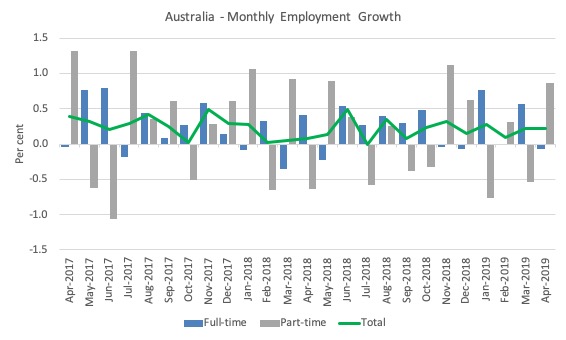
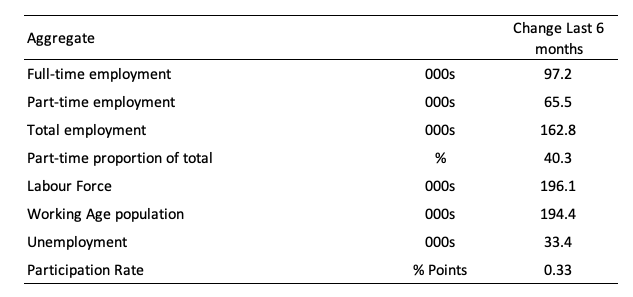


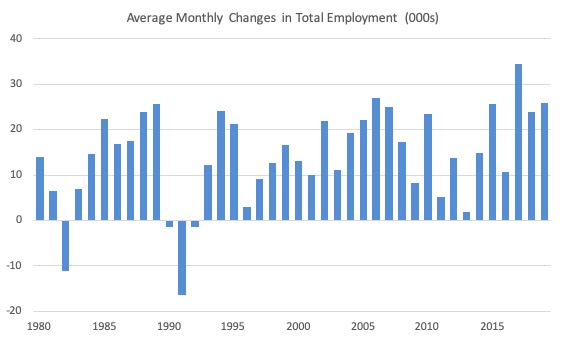
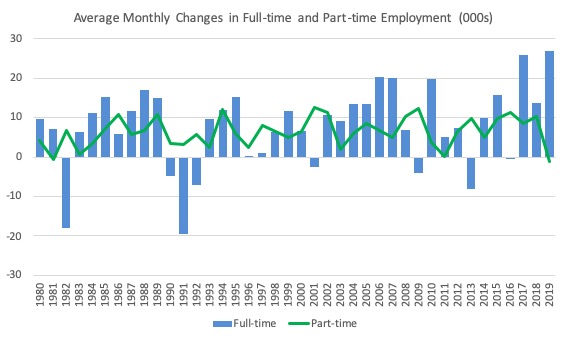
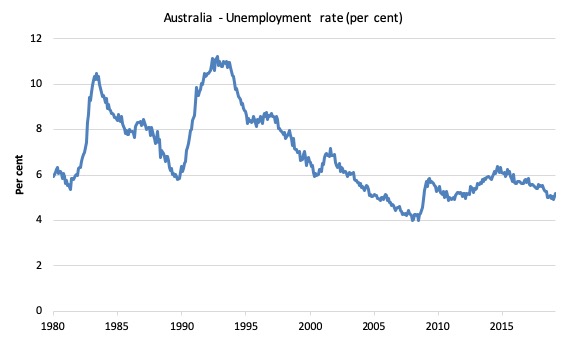
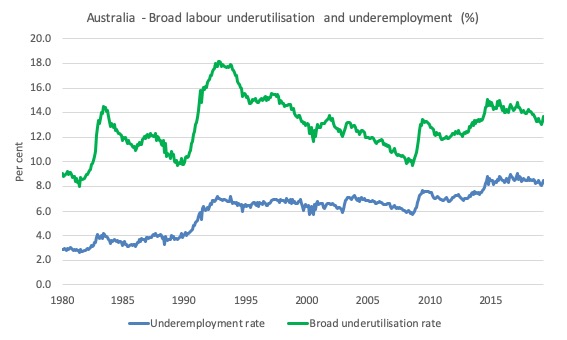
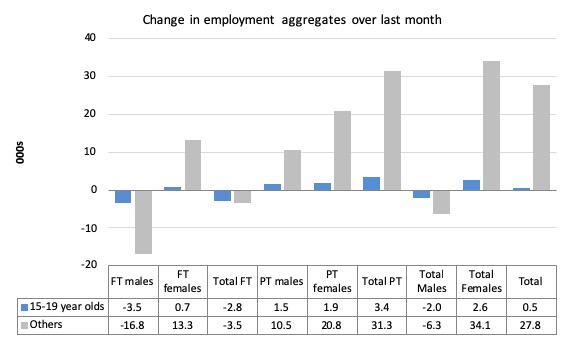
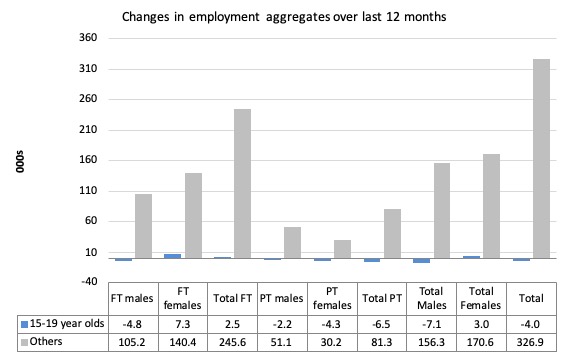
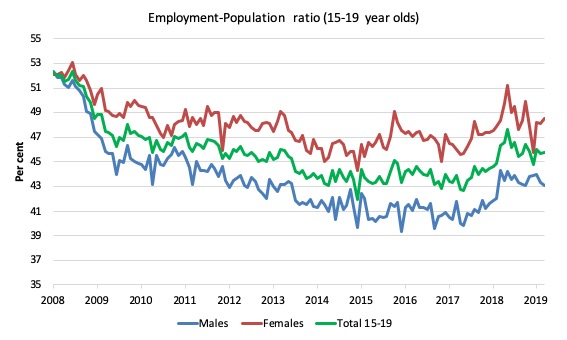
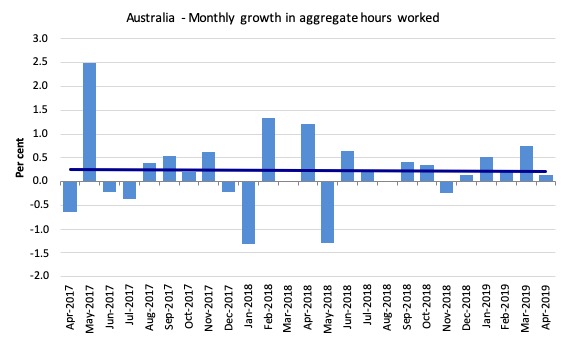
Hi Bill, thanks very much. Hope my question doesn’t betray too much of my ignorance. I worked in DHS (actually CSA) 2003 to 2018. I saw a significant number of males ending up having to get themselves ABN’s in order to accept a job offer they had applied for. They ended up in all sorts of trouble; low and inconsistent income, unable to manage their ABN, unable to lodge tax returns, unable to afford Accountants, unable to even estimate their incomes for CSA. This really bothered me. Also, I have a brother who opted out of banking decades ago and has struggled all this time to manage being a sole trader, right now finally in the process of lodging at least 10 years of outstanding TR’s, had to borrow money of our Dad to afford 2 pay his Accountant to lodge. He calls himself self employed but it’s always been very hard for him. He’s sick now. So I have always assumed employment figures and as misleading at that stupid % is, don’t even include any of these two groups, that I believe are very large. While I’m at it, have you watched employable me? Well from my view I believe the un and under employed population is enormous and I would love to see new truly liveable minimum income (that takes into account rents too, I think poverty line being 50% of median income is stupid.) Going full on here now I’ve started! I want Job Guarantee and truly liveable income starting with under and unemployed including all I’ve just mentioned! I hope this makes sense. If you can answer any of that I will be grateful!
Do upcoming elections provide any hope of policy change?
If the rumored slowling of Chinese economy are true how does Australian fare especially as regards real estate?
I have to admit that Bill is right – there is zero chance of a significant change in economic policy in Australia until the framework used for the so-called “debate” changes. The elections were lost by the Labor because they wanted to close tax loopholes such as “franking credit” and “negative gearing” to “fund” progressive projects. These people who would have lost, have spoken loudly and clearly “yes we want three more years of the guy who hears voices of Holy Spirit in his head while holding a lump of coal in Parliament and locking up illegal asylum seekers in offshore concentration camps”. How evil and retarded is this? At least Scott Morrison doesn’t say openly, unlike his church co-member Israel Folau, that people like me who have rejected the so-called gospel of Jesus C, will go to hell. But the real hell on Earth destroying our natural habitat is coal powered and Scott Morrison is going to provide fuel for the next three years. Why can’t we simply hire a clown to be our next greatest leader, like in Ukraine?
When my Chinese colleague told me 10 years ago that their democratic system was better than ours I kind of wasn’t convinced (having experienced living under “real socialism” for over 20 years). Perhaps it is time to reconsider. Do we actually have “democracy” if people are unable to choose consciously because they are so brainwashed? If this brainwashing is the main constituting feature of Western liberal democracy, it is probably better to outsource decision making to the Politburo. They have fewer vested interest than Serco or G4S. If someone gives consent to sex after ingesting GHB hidden in a drink, this is still considered to be rape. Our GHB is called the Loanable Funds Theory but the system where the brainwashed give consent is still a “democracy”. I am sorry but Marx and Engels anticipated this outcome in the 1870s.
The fact that the debate has been framed as “rising taxes to fund expenditure” and “taking away one’s superannuation savings to finance wasteful investment” has predetermined the results of the “debate”. Within this framework our sovereign government cannot create spending power out of nowhere. Governments are like households. But banks can create spending power ex-nihilo – if someone who wants to borrow has enough equity (“capital”). So this is a question of having access to “capital”. The government has to either borrow money from the ones like Clive Palmer (his personal activity could have tilted the election), sell more assets to the Chinese government or tax the retirees who would then rebel. We need to understand that the wealth of the rich mining magnates is a result of imposing British colonial property rights over the land which previously had belonged to traditional owners, who were mass murdered by the colonisers. The doctrine of “terra nullius” is probably the greatest “white” lie one could imagine in Australia – and it is not white. There is nothing natural in the current system property rights – it has been imposed with the use of force by the past and present ruling social classes. Since the Roman times we live in the world of exogenous money but the facade has been made in such a way that it resembles the loanable funds world and barter economy.
I would repeat – no meaningful debate is possible without changing the macroeconomic framework used to describe the world. No space travel is possible in a geocentric universe. Expressing progressive views and left wing activism within the current framework is waste of time.
” no meaningful debate is possible without changing the macroeconomic framework used to describe the world”.
Yes, so in a world of real politics, progressives need to clarify: can a government manage an above-poverty level Jobs Guarantee, without confiscating wealth from the already wealthy?
[Even if public ownership of natural resources (eg, iron ore) is an area needing examination, in order to implement the JG?]
MMT seems to offer a way out of the present neoliberal straight-jacket, so if we can demonstrate that no-one loses, what’s the problem?
A few basic premises of MMT:
1. A sovereign govt. can issue its own currency, limited only by the real resources including labour available for purchase.
2. The currency has value only because citizens require it to pay taxes.
3. Government doesn’t need to levy taxes (or sell bonds) in order to spend; taxation is a tool for managing sustainable economic activity.
These basic tenets, if correct, are quite easy to comprehend, so why would it be difficult to gain electorate-wide acceptance of MMT?
Dear Neil Halliday,
1. In the realistic scenarios applying to Australia the govt can manage an above-poverty level Jobs Guarantee without confiscating wealth from the already wealthy. The increase in aggregate spending (if the current taxation rules are unchanged) will actually lead to an even higher level of saving by the rich, corresponding to a higher rate of accumulation of financial assets (as the level of productive investment won’t change much). There might be secondary effects on the exchange rate, etc. The real threat is the political emancipation of the poor and the end of the (neo) liberal brainwashing.
A couple of years ago I visited the town called Katherine in the NT, one of the most shocking places I have ever seen in the so-called “developed world”.
“According to the Australian Bureau of Statistics, Katherine Region has a rate of 1516 people per 10,000 population experiencing homelessness – that’s more than twice the NT average rate and 31 times the national average rate.” (Dani McDonald, NT News July 26, 2015)
Let’s imagine that some of the homeless Aboriginal people inhabiting that town find employment initially on building social housing and some of these who find employment, manage to escape the trap of substance addiction (mainly “grog” successfully introduced by the British 200 years ago but also other drugs). There will be an ever growing group of people who are not thankful to the mining tycoons for the bread crumbs of employment, falling from their tables. Even worse – they won’t have to compete for (artificially) scarce jobs – they will just need to show up to work. Someone may then even start questioning why we need people like the tycoons in our society (oops “there is no such thing as a society”). I have historic reasons to believe that this would be the case but I don’t have time to write about it now.
Someone else may ask why the ultra-rich were allowed to hoard so much wealth, why the society tolerates them by protecting their property rights or why Aboriginal people became dispossessed in the first case and why their culture was destroyed in the name of spreading the true religion of Jesus C. and the enlightened Western Civilisation based on “absolute and natural property rights”. As we know, the Aboriginals who objected to the establishment of Western property rights on their land were murdered.
Why is this relevant?
We all remember how the “intellectual property rights” were invented, extended and established in the digital domain in the 1980-s. Virtually nobody would think about software patents in the 1970-s. Now the Chinese are branded the enemies of the humanity because they refuse to accept that they have no right to develop the high technology – only the Americans possess the virtual property in this realm and they think they are entitled to levying fees for using such inventions as a 1-mouse click ( US patent 5960411, expired in 2017). But regardless of what they say, the Americans are physically unable to bully China into accepting this diktat. It is probably 20 years too late. It is just a matter of time people across the world will laugh at the American Empire and their inventions such as the “liberal democracy” – their empire will share the fate of imperial Spain, Portugal, The Netherlands, Austro-Hungary, Russia, the UK and France which belong to the dustbin of the history.
2. That’s why we cannot (and should not attempt to) demonstrate that nobody loses if the JG is introduced. The 1% lose. The monopoly of the capitalists and the banking sector for the possession and creation of spending power is broken by the state and the society is drifting towards “socialism” (maybe without the Chinese characteristics), that is the system where the means of production are no longer solely in private hands (in China they are still effectively 50% nationalised). It is the well hidden in the plain sight “socialism with the Chinese characteristics” what is the true target of the American sanctions. (Yes I know it is imperfect but so what? It is a historic phenomenon not an ideal creation) The government sector funding of R&D in high technologies goes against the principles of “free market economy” and this is precisely what the Americans hate.
We also need to understand that property rights in China are defined differently as even the tycoons cannot just do what they want with their property – they are allowed to high level of personal consumption but regarding business decisions they have to obey instructions coming from the CCP which is the guarantor of their wealth. But this guarantee, unlike in the Western countries is purely conditional on working for the common good under the tight supervision of the Party and within the Social Credit framework. This is exactly opposite to what’s in liberal democracies where the political class is hired, paid and supervised by the 1%. That’s why western propagandists describe CCS as Stalinist. Because they failed to spoil and ideologically poison them with the neoclassical economics and liberalism, unlike the Soviet Communist party, which was induced to self-destruct. The Chinese CP reformed the economy under Deng Xiaoping and has never been stronger than now.
3. I think we need to wait a few more years until the Western 1% will realise that the American emperor is naked and the horse has bolted. They will come back begging the workforce to please accept the sharing of profits just as when Uncle Joe was lubricating his T-34 tanks after driving them through the streets of Berlin. It needs to get worse before it gets better – hopefully there is no global war by then. But I doubt whether MMT will ever be tolerated on the tightly managed marketplace of the ideas in the so-called liberal West as it might erode the true principle of the Western “democracy”: one dollar spent on brainwashing – one vote.
Not much chance of the new Australian government moving off the neoliberal austerity bandwagon I guess?
@Adam K – do not underestimate the power of the electorates perception of how good someone does or does not look and sound in a suit. While the issues you mentioned were certainly a factor, the number one factor across the most populated parts of the country to my mind can be summed up in two words – Bill Shorten.
The bloke is quite simply un-electable in all but the safest of Labor seats. He has had absolutely zero appeal to the public the entire time. When you are trying to sell something, the quality of your product is often less important than the quality of the salesman and Shorten does not have a single salesman’s bone in his body. The public have never taken to him and when they stood at the voting booth large numbers thought ïf I vote for Labor….Bill Shorten will become PM. And we do not think he is fit to lead this country”
This outcome looks similar to 1993 when it was then the Coalition’s turn to lose the “unlosable” election. It should have been virtually impossible for Labor and Keating to have been returned after presiding over the country’s worst economic downturn since the great depression. But the Coalition had made a fatal mistake – they had committed to running with Hewson as leader. And when presented with the choice, the electorate decided that they simply could not vote for a party who would make John Hewson PM – a man they perceived as an incompetent weakling. They did not see Hewson as fit to lead the nation and so returned the “economic wreckers” to power.
In the areas where the bulk of this country’s population reside, I think politics and policies were pretty much a side show to this result – it was all about personalities. A quality the public have always perceived Shorten to be utterly lacking. And when it doubt – they stuck with the status quo.
Dear Leftwinghillbillyprospector,
We should have hired Zelensky, a stand-up comedian who won elections in Ukraine.
The issue is in my opinion different.
1, What do we have TAI and other similar bodies for? Yes they are doing a great job pushing back against Adani but this is nearly not enough.
If the prevalent and unchallenged macroeconomic narrative is “fiscal responsibility” and “returning to the surplus” since the federal budget is like a household budget and you can’t spend what you haven’t earned or borrowed, even a small kid knows that the Liberal will be more fiscally conservative than the Labor and deliver “better” results.
It is a matter of defining the metrics and objective function what determines the optimisation results.
The Liberals will even manage lowering the taxes for the retirees. Never mind thrashing the CSIRO, screwing up the NBN and defunding the universities. Or pushing more young people into poverty and further damaging the fragile environment.
Bill Shorten choose to wrestle a pig and his face is now covered with mud.
The prevailing narrative and the framing have to be challenged NOW or the Liberals will win again in 3 years time. This requires spending a significant amount of money on a relentless educational / propaganda effort and getting things organised in a professional, not ad-hoc, way. It’s time to roll main battle think-tanks not fiddle with new New-Keynesian editions of “zombies” which are fairy tales good for the kids who can’t sleep and for well-wishing intelligentsia.
2. Only when the battleground has been prepared, a new well-groomed leader armed with new fresh ideas should emerge. Otherwise he/she will again have to wrestle a pig – and lose.
3. Otherwise it is just better to give up and stop deluding ourselves – the effort is futile.
@Adam K – I share all your sentiments there. As much as I wanted to see the Coalition turfed out, Labour’s “our surplus will be bigger than theirs” assertion leads me to doubt they would have been much better overall, though I still feel they would have been the lesser of two evils.
The remarkable thing is how Labour was able to win every single poll in the last three years including those taken just before the election and still lose. The polling agencies are telling us that there has never been such a massive error (which ALL of them made) in the history of Australian federal election polling – the breath and scope of this error is unprecedented. Did every single professional pollster utilise the exact same flawed methodology to consistently arrive at the same flawed result for several years running?
We’ll wait for further post-mortem results to hopefully clarify things but at this point in time it seems difficult to see how every professional pollster in the country could get it so completely and utterly wrong……..unless lots of people indicated for the past three years that they would do one thing but then on the day, they changed their minds and did the opposite. The Coalition were as amazed by their own victory as Labour was by it’s own defeat!
My concern now is how Labor will interpret this. It may well be that they decide the electorate have indicated that Australians are inherently strongly right-wing in political outlook and that therefore, the party need to move further to the right if it is to have any chance next time round.
“The Coalition were as amazed by their own victory as Labour was by it’s own defeat!”
I should have added that both parties own internal polling showed similar results as the pollsters – hence the surprise/shock all round. Perhaps pollsters themselves can tell us what the mathematical odds of everyone being totally wrong time and again are.
Until someone comes up with conclusive evidence of every pollster plus both the parties themselves all sharing a common flaw or flaws in methodology, I will continue to suspect that large numbers of people who indicated they would vote one way (owing the the abyssmal mismanagement and downright nastiness of the Coalition) changed their minds at ballot box – because they simply did not believe that Bill Shorten was fit to lead us.
A comment from the Gaurdian that I think probably sums it up…..
“The polls cannot account for the respondents lying.
Even the exit polls, which should be 100% accurate given that respondents cannot change their vote after the event, predicted a Labor win.
That leaves us with only one answer to the question, they were wrong because the people they asked answered wrongly, they lied.
The question that needs to be answered then is why did so many people lie about their vote?
The only logical answer can be that they were ashamed.
Labor ran a policy platform based on tolerance, fairness and and compassion. The people rejected the policies, but were too ashamed to admit it.”
So even polls taken immediately AFTER voting still showed Labor winning – the odds against every single poll being wrong are surely stupendous!
–
I still think the polls were correct – voters simply said one thing to pollsters but did the opposite in reality. They had had enough of the Coalition – but could not bring themselves to put Shorten in the big chair.
Dear Leftwinghillbillyprospector,
If for example 5% of the people were unusually p. off and they hated Labor and Greens they didn’t tell they voted Liberal not because they were ashamed of anything but because they were angry. It is not relevant whether they were manipulated or not.
One who has visited QLD will say it is normal there. The same thing happens routinely in Poland.
Nobody needs to lie it is enough not not tell how they voted or what they wanted to do and this introduces massive bias one can’t compensate for if the opponents are open about their intentions.
Personally I never take part in any polls or marketing surveys because it is nobody’s business what I think – out of lack of trust of the corporate world and official institutions. I understand libertarian types perfectly well since I think I am one of them, the only difference is that I dislike corporations and individual bloodsuckers more than the inherently corrupt government. But in QLD it is the other way around.
The Labor have replaced principles with marketing. That’s why they relied on polls and deserved to fail because there was nothing genuine. Now we have to cope with the true liberals not the fake progressives for the next 3 years. “Sad!”
Adam – I would consider the probability of every poll conducted for the last 3 years, both parties own internal polling and exit polling immediately after the event all reaching the same wrong conclusion every single time as being about as remote as the earth being sucked into a black hole sometime in the next 5 minutes. It is so improbable that you could power a Hitchhikers Guide to the Galaxy improbability drive engine off it.
Keep in mind that for the collective polling of all types to have all been so utterly wrong in the exact same way over such a span of time and right up until election day and even after people had cast their votes is apparently an occurrence without precedent in this country.
What kind of mass psychological phenomenon would be responsable for very large numbers of people who were p**sed off with one mob all telling pollsters that they intended to vote for that very same lot – to such an incredible extent that virtually every poll of every kind both before and after produced the same misleading result? I’m not a psychologist but I can think of none.
It’s getting difficult to reach any conclusion other than that large numbers of people lied about their voting intentions – to every pollster for the past few years, to both major parties internal pollings and even to exit polls after the fact. Why they did so is the question.
Dear Leftwinghillbillyprospector,
I respectfully disagree – about the facts and the interpretation. 9News has published today the following article: Emily McPherson, Wrong polls blindsided nation, but ‘Shorten knew all along’
“The published polls were certainly very different from the internal polling the Liberal Party were doing … it was picking up big swings in Queensland,” she said.
…
“The Labor Party polling showed them behind in every key seat in Queensland. Strategists there were very worried about their polling. In terms of gaining seats, they weren’t confident.”
The success rate of phone interviews used by main polling agencies is… 5% (AFR, 15/03/2016). I would consider this kind of data as highly unreliable, with unknown quality. Sample size is usually between one to a few thousand, to get the confidence high enough. Assuming that we initially make 20000 phone calls and the true preferences are split 52-48 in favour of LNP and that the probability of ALP voters answering the call is 5.3% and the probability of LNP voters answering the call is 4.7% (because of any reason) we get the following expected values
20000*0.52=10400 LNP voters, expected value 0.047*10400=488.8
20000-10400=9600 ALP voters, expected value 9600*0.053=508.8
This gives us the expected result about 51% in favour of the ALP
Is is difficult to imagine that instead of 53 out of 1000 only 47 out of 1000 answered the calls because they were not in the mood or all the pollsters chose a wrong sample and didn’t normalise the data correctly? There is no recalibration procedure available between the elections as the true value is unknown, only the consistency between different polling agencies can be ensured. This may explain why everyone got it wrong.
To me the whole thing is pseudo-scientific. It was hysterically amplified by the media in the same way they amplify weddings of celebrities. The methodology used in internal polls is probably more sophisticated as they have more skin in the game.
Adam – that looks somewhat contrary to the information I have seen.
“The New Daily has obtained a copy of the Federal Election Nightly tracking poll prepared by YouGov Galaxy for the ALP.
“Across the 2PP (two-party preferred), there’s 20 seats they are polling. It showed as swing to Labor of 1.5 per cent,” Mr Utting said.”
Then there remains the matter of exit polling based on people telling pollsters how they actually voted on the day – completely different from an opinion poll predicting a result in advance…..
“An exit poll of booths across the nation points to Labor claiming the federal election on the back of a sharp fall in primary support for the Coalition across Victoria and NSW.
The exclusive YouGov Galaxy poll of more than 3300 voters in 33 separate booths showed Labor ahead of the Coalition 52-48 on a two party preferred basis. It is in line with recent Ipsos, Newspoll and Essential opinion polls which all showed Labor leading the Coalition.
In Victoria, where the Liberal Party is at risk of losing up to six seats, the Coalition vote has slumped.
The poll found Labor’s primary vote at 41 per cent, a 5.4 percentage point lift on the 2016 election, with the Coalition’s combined primary down by 4.8 percentage points.”
I understand what you are saying about polling margin of error – what I am saying is: what is the likelyhood of virtually every poll of all kinds taken in the country both before and immediately after the close of the polls all making the exact same error without fail? Can you do the math on that one? The probabilities against it seem astronomical to me.
Even if the polls are as unreliable as you say they should still have chalked up a slew of variable results – but they did not.
Until solid evidence of something else emerges, I remain of the opinion that large numbers of people told the polls that they would do or had done one thing….but in fact did the opposite.
So all I’m really asking is: point out the factor that allowed so many polls across the spectrum both before and immediately after to CONSISTENTLY make the exact same error again and again and again.
All of Australia’s professional poll takers are dying to know the answer themselves.
Exactly the outcome I feared – Fitzgibbon on tv right now saying in not so many words “Labor needs to move to the right and be more like the Coalition in order to win elections”
A bad outcome